
Amédée Jacques (Paris, 4 July 1813 - Buenos Aires, 13 October 1865), often known as Amadeo, was a French-Argentine pedagogue and philosopher and one of the most prestigious educators of his time.

Amédée Jacques (Paris, 4 July 1813 - Buenos Aires, 13 October 1865), often known as Amadeo, was a French-Argentine pedagogue and philosopher and one of the most prestigious educators of his time.
Jacques was the son of Marie Gérard and Nicolas Jacques, a Parisian painter of miniatures. He studied at the Lycée Condorcet and the École Normale Supérieure. He received his doctorate in letters from the Sorbonne at the age of twenty-four, and soon afterwards received a degree in natural sciences. He worked as a docent at the École Normale Supérieure and the Lycée Louis-le-Grand.
He collaborated on Adolphe Frank's Dictionnaire des sciences philosophiques in 1843, and also worked in publishing. He wrote the sections Introduction and Psychologie of Jules Simon and Émile Saisset's Manuel de philosophie à l'usage des collèges.
Jacques clashed with the Minister of Public Education, Victor Cousin, with whom he, Simon, and Saisset differed politically. In 1847, the three professors founded a journal of opinion, Liberté de penser, although Simon soon resigned due to Jacques's collectivist sympathies.
Jacques emigrated to Montevideo, bringing with him a recommendation from Alexander von Humboldt. He intended originally to reorganize the Universidad Mayor, but his initiatives did not win support. Attracted to Entre Ríos by the progressive culture fostered there by its governor Justo José de Urquiza, Jacques decided to move to Paraná. Here he sold his scientific instruments to the local college and acquired supplies for daguerreotypy and surveying, by which he hoped to earn a living.
Jacques moved to Buenos Aires to give free physics lectures, but these were not popular. With Alfredo Cosson, he traveled to Rosario and Entre Rios to produce daguerreotypes. In 1854, now-president Urquiza appointed him director of the land registry. He lived briefly in Córdoba and spent several years in Santiago del Estero, where he was married. He became the official surveyor of the province and conducted an expedition down the Salado River into Chaco. He also continued to work as a baker, and even thought of becoming a sugarcane planter. An account of his expedition, Excursion au Rio Salado et dans le Chaco, was published in Paris in 1857. In it, he recalled the events he had witnessed, including descriptions of the scenery and the customs of local people.
He later moved to Tucumán, where he ran a bakery and worked as a surveyor and photographer, among many other activities, until in 1858 the provincial government appointed him director of the Colegio de San Miguel, based in the old cloisters of La Merced Church, whose professors had moved to Buenos Aires and left it unstaffed. Here he developed further his plan to reform the systems and methodologies of pedagogy. Jacques established the first institute of higher learning in Tucumán, which was praised by Hermann Burmeister and others, which would educate many distinguished Tucumanians such as Delfín Gallo and Sisto Terán. However, military and political disorder led Jacques to resign in 1860. In the Tucumanian newspapers El Eco del Norte and El Liberal, he published important articles about his educational principles.
He then relocated to Buenos Aires, where Marcos Paz, at that time vice president of the republic, designated him chief professor of the Colegio Nacional de Buenos Aires, and following the death of Eusebio Agüero, president of the college. His tenure at the Colegio was recorded by Miguel Cané in his novel Juvenilia, and in Memoria, a pedagogic memoir left incomplete by Jacques's sudden death. At the Colegio he exercised his impulse to transform, introducing new scientific ideas from Europe into the curriculum, and redesigning the curriculum as a means of preparing students to "learn everything".
Along with Juan María Gutiérrez he prepared the Plan de Instrucción Pública (Plan of Public Instruction), which had a major influence on education in Argentina. He also taught chemistry and experimental physics, and wrote Curso de Filosofía, published in France, which formed the basis for the teaching of philosophy in Argentina.
He died suddenly in 1865 in Buenos Aires, Argentina.

Justo José de Urquiza y García was an Argentine general and politician who served as president of the Argentine Confederation from 1854 to 1860.

The Argentine Confederation was the last predecessor state of modern Argentina; its name is still one of the official names of the country according to the Argentine Constitution, Article 35. It was the name of the country from 1831 to 1852, when the provinces were organized as a confederation without a head of state. The governor of Buenos Aires Province managed foreign relations during this time. Under his rule, the Argentine Confederation resisted attacks by Brazil, Bolivia, Uruguay, France and the United Kingdom, as well as other Argentine factions during the Argentine Civil Wars.
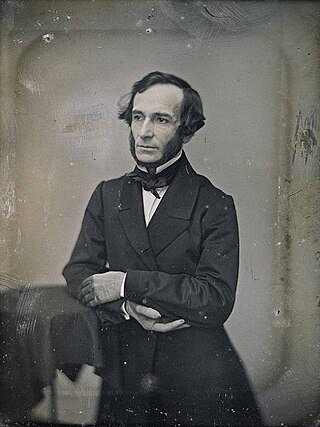
Juan Bautista Alberdi was an Argentine political theorist and diplomat. Although he lived most of his life in exile in Montevideo, Uruguay and in Chile, he influenced the content of the Constitution of Argentina of 1853.
Departments form the second level of administrative division, and are subdivided in municipalities. They are extended in all of Argentina except for the Province of Buenos Aires and the Autonomous City of Buenos Aires, the national capital, each of which has different administrative arrangements.
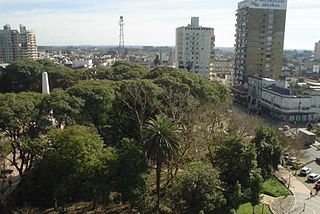
Concepción del Uruguay is a city in Argentina.

The Battle of Caseros was fought near the town of El Palomar, Argentina, on 3 February 1852, between forces of the Argentine Confederation, commanded by Juan Manuel de Rosas, and a coalition consisting of the Argentine provinces of Entre Ríos and Corrientes, the Empire of Brazil, and Uruguay.

Brigadier General José María Paz y Haedo was an Argentine military figure, notable in the Argentine War of Independence and the Argentine Civil Wars.

The San Nicolás Agreement was a pact signed on May 31, 1852 and subscribed by all but one of the 14 provinces of the United Provinces of the River Plate. The treaty consisted of 19 articles, and its goal was to set the bases for the national organization of the young Argentine state. It also served as precedent to the sanction of the Argentine Constitution of 1853.
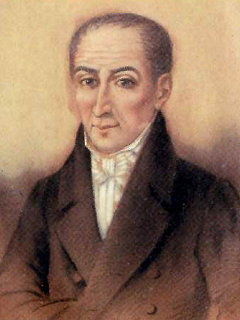
Juan José Esteban Paso, was an Argentine politician who participated in the events that started the Argentine War of Independence known as May Revolution of 1810.

Juan María Gutiérrez was an Argentine statesman, jurist, surveyor, historian, critic, and poet.

The Battle of Pavón, a key battle of the Argentine Civil Wars, was fought in Pavón, Santa Fé Province, Argentina on 17 September 1861 between the Army of the State of Buenos Aires and the Army of Republic of the Argentine Confederation. The withdrawal of Urquiza left the field to Mitre.

Ricardo Ramón López Jordán (1822–1889) was an Argentine soldier and politician, one of the last influential "caudillos" in the history of Argentina. He thrice rebelled against the government of Buenos Aires and was defeated in each attempt.
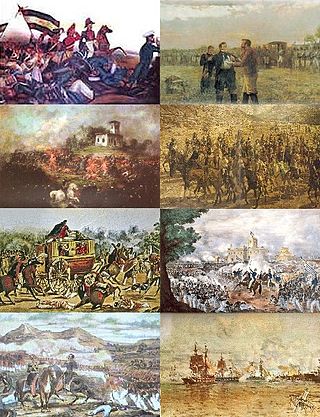
The Argentine Civil Wars were a series of civil conflicts of varying intensity that took place through the territories of Argentina from 1814 to 1853. Beginning concurrently with the Argentine War of Independence (1810–1820), the conflict prevented the formation of a stable governing body until the signing of the Argentine Constitution of 1853, followed by low-frequency skirmishes that ended with the Federalization of Buenos Aires. The period saw heavy intervention from the Brazilian Empire that fought against state and provinces in multiple wars. Breakaway nations, former territories of the viceroyalty, such as the Banda Oriental, Paraguay and the Alto Peru were involved to varying degrees. Foreign powers such as the British and French empires put heavy pressure on the fledgling nations at times of international war.

Pascual Echagüe, was an Argentine soldier and politician. He served as Governor of Entre Ríos and Santa Fe provinces and Minister of War and Navy during the governments of Urquiza and Derqui. He participated in the Argentine Civil Wars and the Uruguayan Civil War.

The State of Buenos Aires was a secessionist republic resulting from the overthrow of the Argentine Confederation government in the Province of Buenos Aires on September 11, 1852. The State of Buenos Aires was never recognized by the Confederation; it remained, however, independent under its own government and constitution. Buenos Aires rejoined the Argentine Confederation after the former's victory at the Battle of Pavón in 1861.

The Argentine Civil Wars were a series of internecine wars that took place in Argentina from 1814 to 1876. These conflicts were separate from the Argentine War of Independence, though they first arose during this period.
The Battle of Laguna Limpia, was part of the Argentine Civil Wars. It happened in the southwest of the Corrientes Province, Argentina on 4 February 1846, when the army under Entre Ríos Province governor Justo José de Urquiza, defeated and captured the commander of the vadvanced columns of Corrientes' army, Juan Madariaga.
Events in the year 2022 in Argentina.
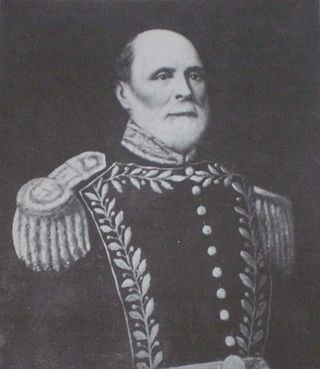
Manuel Hornos was an Argentine general who participated throughout the Argentine Civil Wars and the Paraguayan War. He was known for his service at the Battle of Tuyutí where he was a major contributor to the Argentine victory at the battle.

The Colegio del Uruguay is an Argentine educational institution, created by then Governor of Entre Ríos Justo José de Urquiza in the 28th of July of 1849. It was the first in the country to be secular and free. Nowadays, it serves circa 1200 students.